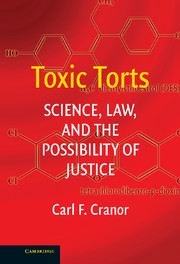Book contents
- Frontmatter
- Contents
- Preface
- 1 The Veil of Science over Tort Law Policy
- 2 Legal Background
- 3 Institutional Concerns about the Supreme Court's Trilogy
- 4 Studies of Toxicity and Scientific Reasoning
- 5 Excellent Evidence Makes Bad Law: Pragmatic Barriers to the Discovery of Harm and Fair Admissibility Decisions
- 6 Science and Law in Conflict
- 7 Enhancing the Possibility of Justice under Daubert
- 8 Is Daubert the Solution?
- Bibliography
- Index
6 - Science and Law in Conflict
Published online by Cambridge University Press: 08 January 2010
- Frontmatter
- Contents
- Preface
- 1 The Veil of Science over Tort Law Policy
- 2 Legal Background
- 3 Institutional Concerns about the Supreme Court's Trilogy
- 4 Studies of Toxicity and Scientific Reasoning
- 5 Excellent Evidence Makes Bad Law: Pragmatic Barriers to the Discovery of Harm and Fair Admissibility Decisions
- 6 Science and Law in Conflict
- 7 Enhancing the Possibility of Justice under Daubert
- 8 Is Daubert the Solution?
- Bibliography
- Index
Summary
When scientific evidence is centrally needed to assist legal decisions, the Supreme Court, inter alia, aimed at increasing the chances that legal decisions would more closely follow or at least not be at great odds with the relevant science. This is not as easy a task as it might have seemed. For one thing, generic tensions between the law and science hamper easy pursuit of this goal. In addition, given the complexity, subtlety, and near inscrutability of some scientific evidence, judges understandably, but regrettably often struggle with scientific studies and reasoning. These difficulties increase the more complex and subtle the evidence becomes. Moreover, judges may have disagreements with one another about how scientific evidence should be reviewed, given its complexity. Finally, the chances that admissibility decisions will result in mistaken judgments are even greater given some of the pragmatic problems reviewed in the previous chapter. That is, even when judges review quite good evidence, there are numerous opportunities for errors. When there are myriad pragmatic barriers to obtaining good evidence about the toxicity of substances and less than optimal evidence is available, the potential for stresses and strains increases. Failures to attend successfully to these issues pose threats to the legitimacy of the law as an institution.
The current chapter focuses on some of these issues; the next chapter suggests a partial corrective to them. This chapter first reviews some tensions between science and the law that can affect how well they can function together.
- Type
- Chapter
- Information
- Toxic TortsScience, Law and the Possibility of Justice, pp. 205 - 282Publisher: Cambridge University PressPrint publication year: 2006



